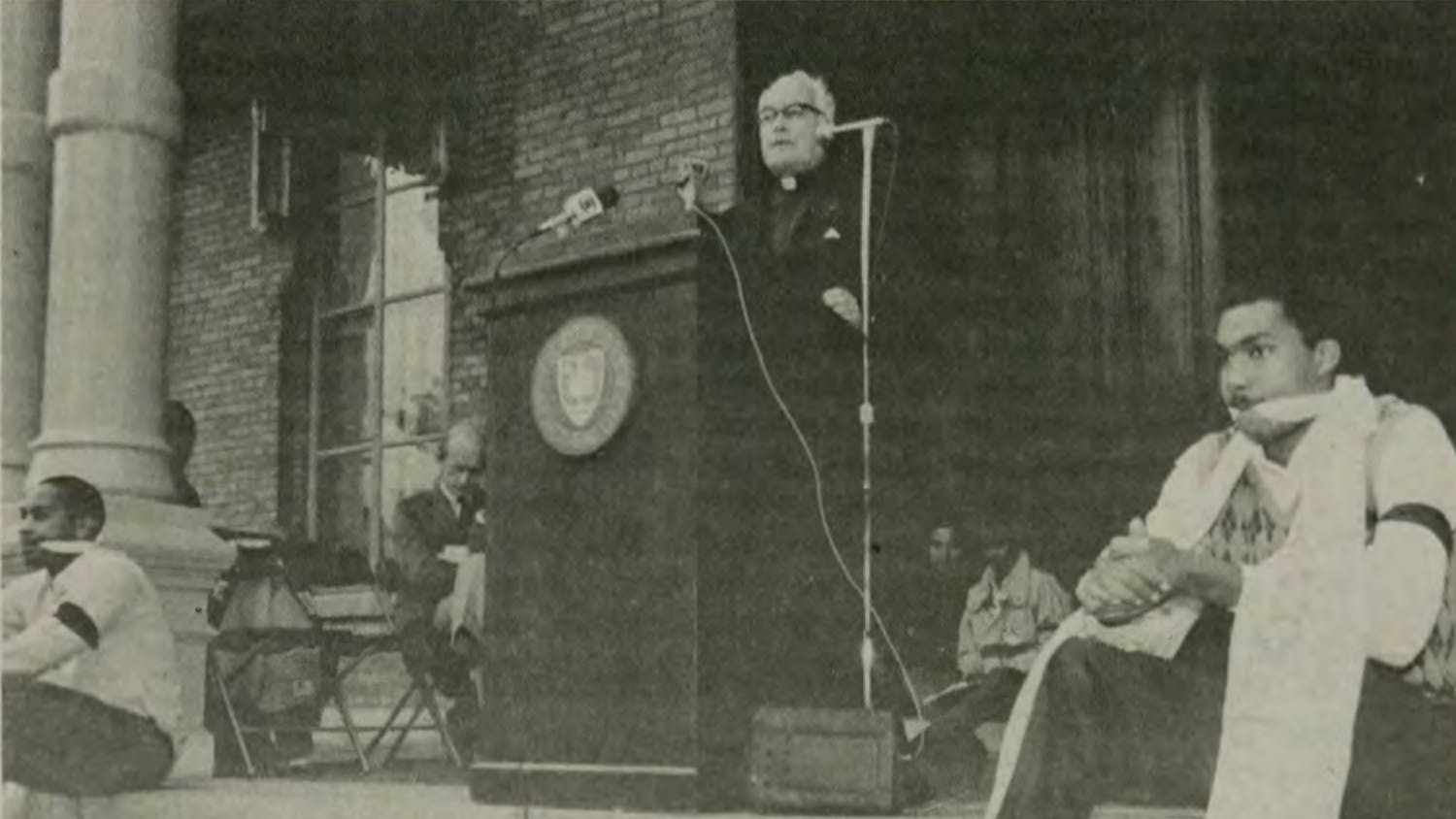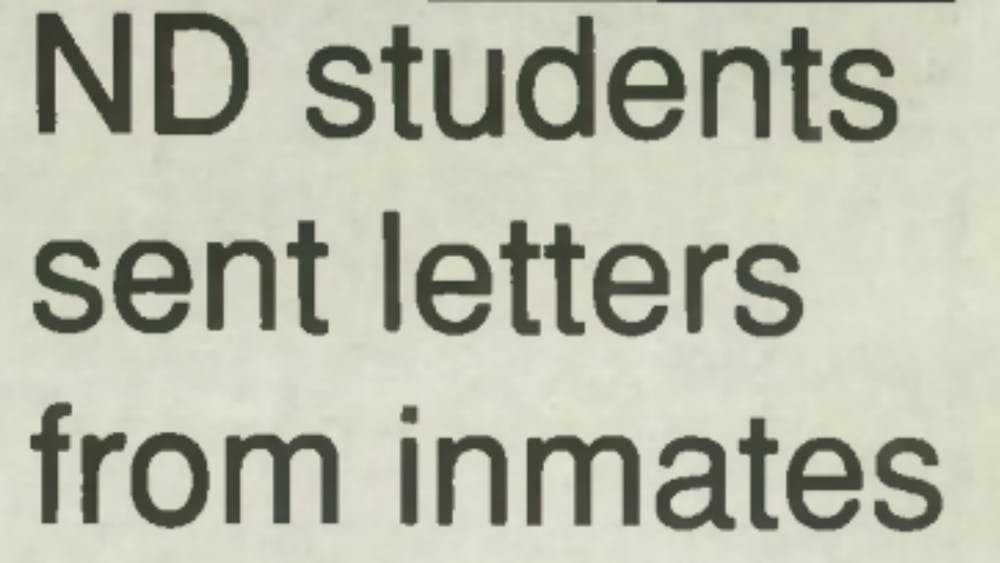Parietals continue to be a consistently controversial topic at Notre Dame, almost universally igniting the ire of the student body. While this policy may seem to be an eternal annoyance, in fact parietals as we know them date only to the late 1960s and are intertwined with the process of coeducation at Notre Dame, now in its 50th year.
In this two-part series, From the Archives will explore the early history of parietals. In this first installment, we uncover the University administration’s initial opposition to parietal hours, their subsequent change in heart and the promises and pitfalls that arose when parietals were first implemented.

Hesburgh’s “emphatic” opposition to parietals
Nov. 9, 1967 | Observer Staff | April 1, 1968 | Observer Staff | Researched by Avery Polking
Though the social structure of Notre Dame is defined by many things, perhaps one of the most concrete influences on daily life — and the most adverse to students — is parietal hours. While its vast unpopularity among students is well documented, less known is that University administration was initially against them as well.
A November 1967 Observer headline announced, “Hesburgh Emphatic: No Parietal Hour.” The article examined the implications of a comment then-University President Fr. Theodore Hesburgh made in which he effectively called parietal hours pointless, commenting that he “[has] no stomach for laws which don’t mean anything.”
“I’m sure that parietal hours will not be allowed,” Hesburgh declared.


The Observer expanded on Hesburgh’s stance, reporting that “The University’s reason for not allowing girls in the dormitory stems mostly from the social repercussions of entertaining a girl in a bedroom and the disruption such a practice would initiate in a mens’ dorm which is interpreted by many university officials as a men’s club.”
Hesburgh valued a community in which men and women could work together without the burden of time restrictions, calling this dynamic a “tension modulated by love.”
But not long after in April 1968, Hesburgh showed signs of a softening stance by reinstating four students who had been suspended by James Riehle, dean of students, for an unspecified parietal violation.
Hesburgh acknowledged that there was “moral ambiguity” present in current restrictions and that he was “in the process of outlining a program” he hoped would clarify matters.
Parietals were ultimately approved by the Board of Trustees a year later. However, the contentious conditions under which parietal hours were first debated surely reflects their controversial nature, still evident today.
Parietals approved
March 18, 1969 | Observer Staff | March 28, 1969 | Ted Price | Researched by Lilyann Gardner
Parietals are perhaps an outdated practice in the opinion of many present-day Notre Dame students, but their initial approval was likely considered a win in the eyes of the entirely male student population of 1969.
Despite Father Hesburgh’s ostensibly “emphatic” opposition to parietals, in March 1969 the Board of Trustees approved the expansion of female visitation hours from just 11 weekends per year to every weekend, with the expectation that certain changes would have to be made to residence halls.
“The Executive Committee ratified the Student Life Council’s proposals for a reorganization of the residence hall governments, including a written constitution, a hall president, a hall legislative council, and a hall judicial board,” The Observer reported.
The Student Life Council and Board of Trustees made it clear that should any hall fail to make the necessary changes, they would not be granted the privilege of expanded visitation rights.
Parietals, although approved by administrative powers, were entirely experimental and relied on student cooperation. However, disgruntlement about these mandatory changes was not an issue.

Roughly a week later, six out of the 12 residence halls were approved to implement the new parietal rules. These halls included Badin, Carroll, Keenan, Lyons, Pangborn and Zahm with the other six following after minor changes in their hall constitutions were made.
These residence halls moved forward with detailed weekend visitation hours that share similarities and differences with the parietal hours instituted after the move to co-education.
“The legislation passed by the SLC and approved by the trustees permits women visitation hours in the residence halls for a total of no more than twenty-four hours from 5 p.m. Friday through 11 p.m. Sunday. However, no hall’s may extend beyond 1 a.m. any day nor begin earlier than 1 p.m. any day but Friday,” Ted Price (‘71) wrote.
Violations of parietals were expected, but the Board of Trustees believed that the additional hall councils and authority figures would help maintain a certain level of maturity and morality in the campus community.
Whether or not parietals are a necessary good or a necessary evil is up for debate today, but at the time of their approval parietals seemed to be a positive step toward creating a more inclusive campus community
Early parietal problems: sign-ins and citations
Oct. 1, 1969 | Observer Staff | Nov. 6, 1969 | Don Ruane | Researched by Cade Czarnecki
Though approval of parietals was met with enthusiasm, their implementation quickly led to a proliferation of student complaints.
The parietal policy, as it initially existed, required visitors to sign both in and out on a sheet in the entrance of the hall they were visiting, denoting the time of both arrival and departure.
A hall member was required to sit next to the sign-in book and ensure that all visitors adhered to the policy. The consensus among the student body was that the sign-in process was a ridiculous and unnecessarily tedious requirement.
As evidence of the absurdity of the requirement, an Observer article shared that “hall presidents [asked] each of their halls to enforce the sign-in procedure [on the] weekend to the letter and to make fathers visiting their sons sign in their wives and small daughters.”
The grievances did not stop there. Others writing in The Observer opined that the sign-in process served no real purpose: “No one…ever stated what the [sign-in] list was to be used for — whether to check as to if the women had left at the sign-out hour or what.”
Parietal violations began to occur almost as soon the policy was enacted — some due to ignorance and others due to protest.
Transgressing halls were often reported by rectors of other dorms. In fact, the Hall Life Board conducted an investigation into seven halls known to be repeat parietal offenders: Holy Cross, Dillon, Walsh, Alumni, Flanner, Carroll and Morrissey.

The Hall Life Board threatened these halls with the suspension parietals as a whole if they did not clean up their acts. The board also promised a follow up investigation to ensure the appropriate changes in conduct were made in these recurrently offending halls.
While some saw the actions of the Hall Life Board to be oppressive, executive coordinator Ron Mastriana defended its investigation, saying, “The purpose of the Hall Life Board is to help the halls along and to make sure that everything is working as it should.”
While Mastriana’s comments undoubtedly soured some students even further on the Hall Life Board, there was a general belief that the Hall Presidents Council would actively work to help revise the parietals system in a way agreeable to all parties involved.
Contact Spencer Kelly at skelly25@nd.edu
Avery Polking at apolking@nd.edu
Lilyann Gardner at lgardne2@nd.edu
Cade Czarnecki at cczarne3@nd.edu












